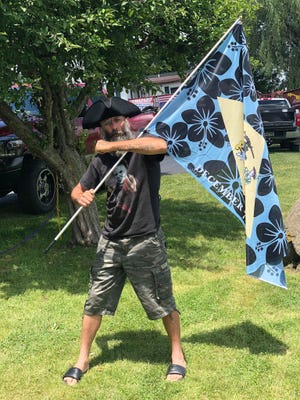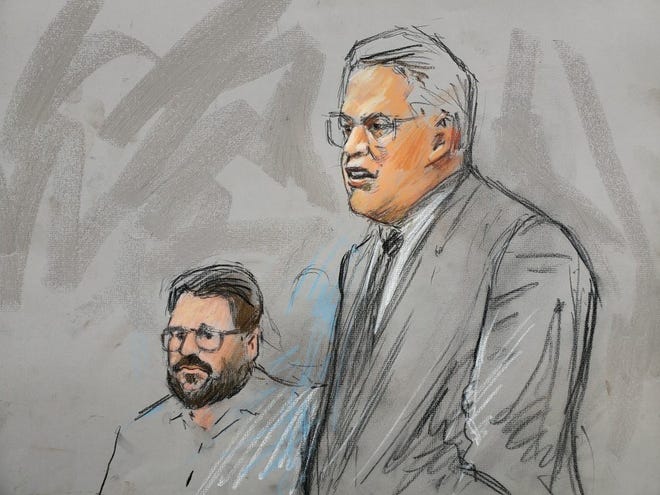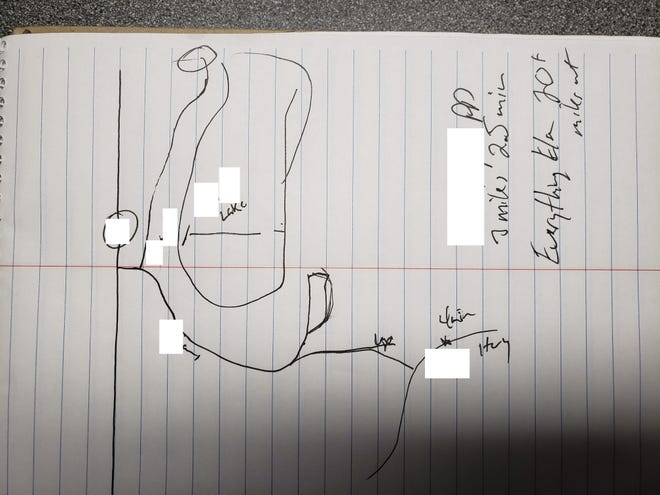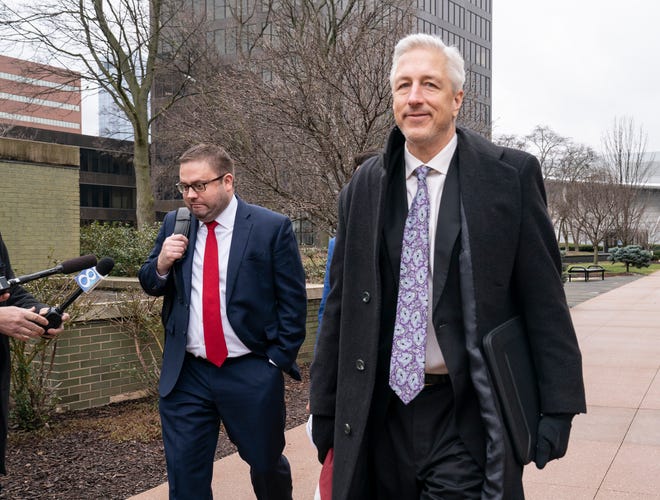GRAND RAPIDS — Both sides in the Gov. Gretchen Whitmer kidnapping retrial ramped up their intensity during opening statements Wednesday, hammering away at certain themes more aggressively and precisely than they did the last time.
The prosecution laid out a more concrete timeline and more strongly emphasized that the alleged kidnapping plan was hatched before the FBI ever got involved. And the defense urged the jury to consider the actions of several FBI agents and informants who won’t be testifying at trial, essentially planting seeds in the jurors’ minds that there may be more to this case than meets the eye.
The first trial in the case ended with no convictions. Two men were acquitted. The jury deadlocked on the two others, triggering a mistrial, so the government is trying again.
Prosecutors: This wasn’t entrapment
The prosecution, which went first, took aim at the defense’s entrapment theory right out of the gate, emphasizing repeatedly that the defendants wanted to harm the governor long before they encountered the undercover FBI agents and informants who infiltrated their militia group. Prosecutors stressed that the case is about more than just COVID-19 restrictions.
The case involves six militia members who were charged in 2020 with plotting to kidnap Whitmer, planning to blow up a bridge near her home to slow down law enforcement, out of anger over her handling of the pandemic. Two have pleaded guilty. Two were acquitted at trial in April. Adam Fox and Barry Croft face this retrial after the jury deadlock.
O’Connor told jurors Croft and Fox masterminded the kidnapping plot and planned and recruited members to carry it out, stressing this was all part of a bigger plan to spark an American revolution.
More:Will feds salvage Whitmer kidnap case? ‘The key is jury selection,’ experts say
More:Meet the jurors in the Whitmer kidnap retrial — most don’t like the news
“Long before these defendants planned and trained to kidnap the governor of Michigan, they called for a second revolution. They wanted to violently overthrow elected officials, because they believed those officials were tyrants who were violating their rights,” Assistant U.S. Attorney Christopher O’Connor told jurors, adding that the defendants believed “that all it would take to start that revolution is to hang a governor.”
O’Connor then laid out a timeline in an effort to show the jury how the alleged Whitmer kidnap plan unfolded before the FBI got involved — a timeline that was more difficult to follow in the last trial. Here’s how he summarized events for the jury:
“Ladies and gentlemen, this case doesn’t start because of COVID-19 … it’s not just because of Whitmer’s response to COVID-19,” O’Connor said. “What you’ll learn is that years before law enforcement started investigating this plot, the defendants believed officials were tyrants and talked about taking violent action against them … These two men wanted to hang, grab, kill elected officials long before they decided to kidnap the governor.”

‘These defendants were eager’
According to O’Connor, Croft, a trucker from Delaware, fell on the government’s radar in 2017, when he started talking about starting a revolution. By 2020, Croft launched a call to action: He wanted to kick off his revolution by hanging a governor.
Croft would eventually meet Fox and tell him about his plan, O’Connor said. The two set their sights on Whitmer and hatched a plan to kidnap her, with Fox agreeing to recruit members, O’Connor said.
“I’m on board man. I’m going to actively begin recruiting, I can’t wait … I’m not going to call myself militia. There ain’t going to be no participation trophy … we’re going to put together a group to go snatch a motherf—–,” Fox tells Croft in an audio message that was played for the jury.
The prosecutor then stressed this point:
“They did this before they ever met an undercover agent, and before they met Dan,” O’Connor said, referring to the undercover informant known as “Big Dan,” whom the defense claims tried to entrap the defendants and ran the whole show.
O’Connor blasted that theory.
“The defendants will ask you to believe that none of this was their idea, that they were entrapped by the FBI. They want you to believe that the FBI made them do what they did, say what they said. The evidence will show you that’s simply not true,” O’Connor said.
O’Connor told jurors they “will not hear evidence that the FBI came up with this plan, that an FBI agent forced someone to do this … that these guys were reluctant … and that this reluctance had to be beaten down by government agents.”
Rather, O’Connor said. “Adam Fox and Barry Croft talked about doing this for a long time. These defendants were eager.”
More:Whitmer subpoenaed to testify in Michigan case preventing abortion-related prosecutions
More:Michigan inmate dying of cancer begs Gov. Whitmer for freedom after 46 years
Not just ‘silly talk’
O’Connor also scoffed at defense claims that the defendants were merely big talkers blowing off steam, saying they took action to carry out their plan, including: casing Whitmer’s house twice, building “shoot-houses” where they practiced breach exercises in mock hallways, drew a map, bought night goggles, spoke in encrypted chats and secret meetings, and took steps to conceal their activities from law enforcement.
For example, O’Connor told the jury, Fox referred to bombs as “cupcakes” and “wedding cakes” in chats, and referred to his explosives contact Up North as a “baker.” Fox also once held a private meeting in the basement of a vacuum shop where he lived and required all the attendees leave their cellphones on the first floor.
“Why were they engaged in that if this was just silly talk? If this wasn’t a real plan?” asked O’Connor, who summarized the plot like this:
“They were going to break into the governor’s cottage Up North, kidnap her at gunpoint, and take out anyone who got in their way,” O’Connor said. “They planned to handcuff her, to take out a bridge to slow the police response. This wasn’t just talk … these defendants and others took specific steps.”
The prosecutor told jurors they will hear Fox’s ideas, how the governor was his target, and how he told his cohorts: “We just want the bitch. We want the tyrant bitch. We want her flex-cuffed in handcuffs.”
Jurors also learned they will hear from two codefendants, Ty Garbin and Kaleb Franks, who previously pleaded guilty in this case.
“They will tell you how real this plan was,” O’Connor said, “that it isn’t just talking.”

‘Facebook big talkers’
Christopher Gibbons, Fox’s lawyer, started his opening statement by reminding jurors about evidence they won’t hear — FBI agents and informants who are crucial to the case, but will not be testifying.
“There are a lot of them. Some will testify, others will not,” Gibbons told the jury. “They will never answer a single question in this courtroom.”
As in the last trial, Gibbons repeatedly used the term “big talkers,” arguing that this case is about rogue FBI agents and informants who took advantage of unsophisticated blowhards who spewed all sorts of venom.
It started with the FBI encountering what Gibbons referred to as “Facebook big talkers” venting on social media about government. But after months of following the defendants, he said, the FBI hadn’t uncovered “any criminal activity,” just “big talk.”
FBI ‘turned up the heat’
The FBI and its informants “turned up the heat by putting big talkers together,” Gibbons said, alleging the FBI created chat groups, organized meetings and trainings, and egged on the defendants “to turn their frustration into some kind of actionable plan.”
Still, he said, nothing happened. So the FBI and its informants “took matters into their own hands,” planned a visit to Whitmer’s vacation house, found the address, convinced Fox and others to go, and even handed Fox the piece of paper to draw a map of the area they would be scouting.
Big Dan’s FBI handler also once texted: “Got to get Adam focused,” Gibbons said. And two days before the group cased Whitmer’s cottage, the same handler texted Big Dan: “Try to get as many as possible to go.”

“Big Dan is the beginning, the middle and the end of this case,” Gibbons said, noting he sent thousands of texts to Fox, but only a fraction of them will be shown at trial, suggesting the feds are cherry-picking.
“The FBI collected literally more than 1,000 hours of surveillance recordings … you will only hear a tiny fraction,” Gibbons said. “What Big Dan did and said was entirely controlled by the FBI, the FBI had rules for Big Dan. Big Dan broke those rules. He will tell you that himself. He exercised leadership control, suggested ideas, initiated planning for the big talkers.”
Gibbons said Big Dan’s handler “was aware that the rules were being broken,” but the FBI did nothing about it, and the handler “encouraged the action.”
“Adam Fox has never led a thing in his life,” he said. “What this case is really about … how the FBI was unable to really get anybody to do anything.”
“Adam didn’t know where the governor’s cottage was … Big Dan looked it up on a Realtor map,” Gibbons said, noting Fox was enamored with Big Dan, a war veteran who joined the militia and then went undercover after becoming concerned they were plotting to kill police.
“He worships the guy,” Gibbons said of Fox’s admiration for Big Dan, adding his client was vulnerable to manipulation. “Adam Fox goes along with Dan’s suggestions because he is unwitting. He had a big mouth, that is for sure. But the FBI manipulated him.”
The right to criticize
Gibbons concluded his statement by urging the jury to remember the importance of free speech.
“Adam Fox is an American citizen. He may not be the best of us — I don’t think he’s the worst of us,” Gibbons said. “But like all of us, he has a right to have an opinion. And he has a right — (being) homeless and poor in the vacuum shack in the middle of the pandemic — to be angry and frustrated.”
Gibbons stressed: “Talk, no matter how ugly, is not a crime. It’s not a crime to say outrageous things … to not like your governor, or your president or anybody else who sits in elected office.”
Fox, he said, is not the person the government is painting him out to be.
“Adam Fox is lonely, looking for connections. He’s not a leader,” Gibbons said. “He wants to fit in.”
‘Facts matter’
Croft’s lawyer, Joshua Blanchard, painted his client as an outsider when it came to the Wolverine Watchmen — the Michigan militia group at the center of this case. He said Croft wasn’t invited to many of the group’s events because he was different from others who connected through that militia.
Blanchard noted Croft’s differences with other members in the militia, including Daniel Harris and Brandon Caserta, who were acquitted in April — though he didn’t mention that to the jury. Nor did he give their names. Unlike others in the Wolverine Watchmen, he said, Croft was much older, had children and didn’t live in southeast Michigan.
“Barry was never vetted, Barry never joined the Wolverine Watchmen, he was never even invited to be a member,” Blanchard said. “None of these guys are communicating with Barry in these chat groups.”

Blanchard also slammed the FBI, saying government agents were desperate to link Croft with others to conjure a terrorist conspiracy. He noted FBI informants Steve Robeson and Jenny Plunk consistently were in contact with Croft.
“They have to chase Barry around the country with a gun because he won’t take it from them,” he said. “Even with everything (Robeson) and Plunk are doing, they haven’t got enough for the FBI to arrest him as part of the group.”
To round out his closing argument, Blanchard played a short snippet of a recording to the jury, in which FBI Special Agent John Penrod is heard saying “don’t let facts get in the way of a good story.”
Blanchard implored jurors to consider the phrase throughout the trial, stressing:
“He’s been away from his daughters for the last 672 days, waiting for you to tell the FBI ‘facts matter.’”
Witness testimony begins
Just as they did in the first trial, government prosecutors called FBI Special Agent Todd Reineck to the stand as their first witness. During his direct examination, Reineck explained how he went through public Facebook posts from Croft and Fox, as well as video messages between the two where they expressed their frustrations with COVID-19 restrictions and other government policies.
The jury heard recordings where Fox maligned a health order closing gyms in May 2020. Like in the first trial, the government entered evidence of Fox detailing meetings he was going to have with Wolverine Watchmen members in video messages sent to Croft.
Croft’s social media posts were also played for the jury. In one video, posted to Facebook on May 29, he berated the government, saying government actions throughout the pandemic had “provoked” him and others.
“Men have been provoked to wrath … all you men who have that soft-a** stance, f*** you in the throat sideways,” Croft can be heard saying in the video. “The republic needs good men, not pansies, not f*****s.”
During his cross examination of Reineck, Gibbons noted that at no point did Fox explicitly say anything about kidnapping Whitmer, instead usi vague, anti-government language.
The trial will resume Thursday morning with Gibbons’ continued cross examination of Reineck. The trial is expected to last two weeks.
Tresa Baldas: tbaldas@freepress.